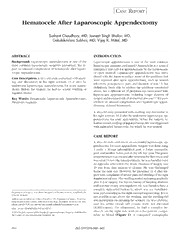
Hematocele After Laparoscopic Appendectomy. PDF
Preview Hematocele After Laparoscopic Appendectomy.
C R ASE EPORT Hematocele After Laparoscopic Appendectomy Sushant Chaudhary, MD, Jasneet Singh Bhullar, MD, Gokulakrishna Subhas, MD, Vijay K. Mittal, MD ABSTRACT INTRODUCTION Background: Laparoscopic appendectomy is one of the Laparoscopic appendectomy is one of the most common most common laparoscopic surgeries performed. We re- laparoscopicsurgeriesperformed.1Appendicitisisasurgical port an unusual complication of hematocele after laparo- emergencythatcallsforappendectomybythelaparoscopic scopic appendectomy. or open method. Laparoscopic appendectomy was intro- duced with the intent to reduce some of the problems that CaseDescription:A48-y-oldmalepresentedwithswell- were reported after open appendectomy, such as wound ing and discomfort in his right scrotum 11 d after he infections, postoperative pain, and duration of stay.2 It has underwent laparoscopic appendectomy for acute appen- definitively been able to address the problems mentioned dicitis. Before the surgery, he had no scrotal swelling or above, but a different set of problems has been noted with inguinal hernia. laparoscopic appendectomy, including longer duration of Key Words: Hematocele, Laparoscopic Appendectomy, surgeryandincreasedriskofabdominalabscess.3–5Wepres- Processus vaginalis. enthereanunusualcomplicationafterlaparoscopicappen- dectomy:delayedhematocele. A 48-y-old male presented with swelling and discomfort in his right scrotum 11 d after he underwent laparoscopic ap- pendectomy for acute appendicitis. Before the surgery, he hadnoscrotalswellingoringuinalhernia.Hewasdiagnosed withright-sidedhematocele,forwhichhewastreated. CASE REPORT A 48-y-old male underwent an uneventful laparoscopic ap- pendectomyforacuteappendicitis.Surgerywasdoneusing 3 ports: a 10-mm infraumbilical port; a 5-mm suprapubic port;andanother5-mmportintheleftiliacarea.Thepneu- moperitoneumwascreatedafterinsertingthefirsttrocarand wassetat14mmHg.Intraoperatively,hewasfoundtohave anappendixadherenttotheileum.Durationofsurgerywas 49 min from skin incision to closure. He was discharged home the next day. However, he presented 11 d after sur- gerywithcomplaintsofseverepainandswellingoftheright inguinoscrotalarea.Theswellingstartedappearinggradually after9dofsurgery.Hehasnohistoryofbleedingdiathesis andwasnotonanyanticoagulants.Hewasfoundtohavea complete right-sided hydrocele, which was not transillumi- DepartmentofSurgery,ProvidenceHospitalandMedicalCenters,Southfield,MI, nantandextendingtotherightexternalinguinalring.Itwas USA(allauthors). notpossibletogetabovetheswelling,andtheswellingdid Addresscorrespondenceto:SushantChaudhary,MD,DepartmentofSurgery,Providence notdecompressonelevatingthescrotum.Hewasafebrile, HospitalandMedicalCenters,16001West9MileRoad,Southfield,MI48075,USA.Tele- and his white blood cell counts were not elevated phone:248-849-7638,Fax:248-849-5380,E-mail:[email protected] (8,300/cumm). On ultrasound, he had a complex hy- DOI:10.4293/108680812X13517013316717 drocele on the right side with an echo pattern compa- ©2012byJSLS,JournaloftheSocietyofLaparoendoscopicSurgeons.Publishedby theSocietyofLaparoendoscopicSurgeons,Inc. rable to blood (Figure 1). A computed tomography 660 JSLS(2012)16:660–662 DISCUSSION Appendicitis is the most common general surgical emergency in the world.1 The currently recommended procedure of choice for treating appendicitis (espe- cially in obese adults) is laparoscopic appendectomy for numerous reasons, including decreased pain and lower narcotic requirement, reduced length of stay in the hospital, fewer wound infections, and quicker re- turn to routine activity.6 In addition, it helps in identi- fyingotherpossibleconditionsthatmimicappendicitis. This is especially important in women of reproductive age.7Thoughtheprocedureissafe,itisassociatedwith possible complications, such as intraabdominal ab- scess. Intraabdominal abscess is 3 times more common afterlaparoscopicappendectomy,comparedwithopen appendectomy.6Therehavebeennoreportsofdelayed scrotal hematocele, to the best of our knowledge. Only one similar report was found in which a patient devel- oped postoperative infected hydrocele on postopera- tive day 1 after laparoscopic appendectomy.8 Similar Figure1.Ultrasoundofrightscrotum.Sagittalview,showingthefluid findings were observed after laparoscopic cholecystec- collection(whitemarker),adjacenttotherighttestis(blackmarker). tomy by Kaner et al.9 in a 54-y-old man on postopera- tive day 1. There were no reports of a delayed devel- opment of scrotal or inguinoscrotal swelling. These researchers postulated that increased intraabdomi- nal pressure from the pneumoperitoneum created during surgeryresultedinopeningoftheprocessusvaginalisand resultedinthepelviccollectiontrackinginthedependent area,9 or a congenital inguinal hernia may have been the cause for the swelling, allowing the fluid to track down the scrotum.8 Both theories are supported by the persis- tenceofpatientprocessusvaginalis.Webelievethatboth mechanisms may be involved, coupled with physical ac- tivity or straining, causing increased intraabdominal pressure andleadingtoasecondaryhemorrhageanddelayedcollection inthescrotum.Similarpresentationsofscrotalswellingsfora distantpathologyhavebeenreportedinpediatricpopulations, but not very often in adults. Scrotal hematoma or swelling in newborns has been associated with a number of diseases, includingmeconiumperitonitis,traumatichemorrhage,adrenal hemorrhages,10andgastricperforation.11 Although present in the majoriy of newborn male in- Figure 2. Coronal view of CT scan of the abdomen and pelvis fants, the incidence of patent processus vaginalis de- showingpelvicfluidcollectioncommunicatingwiththerightscrotal clines to 60% at the age of 1 y and 15% to 37% at collectionthroughapatentprocessusvaginalis. adulthood. It allows the passage of intraperitoneal con- tent from the abdomen to the scrotum. Twenty percent (CT)scanoftheabdomenandpelvisrevealedfreefluid of people in whom the processus vaginalis remains inthepelviscommunicatingwiththerightscrotalswell- patent develop inguinal hernia and hydrocele during ing (40HU) (Figure 2). their life.12 It is bilaterally present in 12% of patients JSLS(2012)16:660–662 661 HematoceleAfterLaparoscopicAppendectomy,ChaudharySetal. with congenital inguinal hernia.13 Smooth muscle has 4. Golub R, Siddiqui F, Pohl D. Laparoscopic versus open been identified in processus vaginalis tissue, but not in appendectomy:ametaanalysis.JAmCollSurg.1998;186:545– the healthy peritoneum. The amount of smooth muscle 553. presentmaycorrelatewiththedegreeofpatency.Forexample, 5. OrtegaAE,HunterJG,PeterJH,SwanstromLL,SchirmerB. higheramountsofsmoothmusclehavebeenfoundinhernia A prospective, randomized comparison of laparoscopic appen- sacsthaninthepatentprocessusvaginalisofhydroceles.Inves- dectomywithopenappendectomy.LaproscopicAppendectomy tigationcontinuestodeterminetheroleofsmoothmuscleinthe StudyGroup.AmJSurg.1995;169:208–212. pathogenesisofthiscondition. 6. CorneilleMG,SteigelmanMB,MyersJG,etal.Laparoscopic Because the collection in the scrotum was organized and appendectomy superior to open appendectomy in obese pa- tients.AmJSurg.2007;194:877–880. therewasnoevidencetosupportanyongoingbleeding,the patientwasobserved.Hewasreferredforinguinalherniorrha- 7. Borgstein PJ, Gordijn RV, Eijsbouts QA, Cuesta MA. Acute phyafterresolutionofthefluidorbydrainageafteraspiration. appendicitis—aclearcutcaseinmen,aguessinggameinyoung women. A prospective study on the role of laparoscopy. Surg CONCLUSION Endosc.1997;11:923–927. 8. Lantsberg L, Mor I, Levy I, Koda J. Infected hydrocele fol- Meticulous hemostasis is of great importance in any lowinglaparoscopicappendectomy:casereport.SurgLaparosc surgery. Better hemostasis could have prevented the Endosc.1997;7:262. swelling. Surgeons should avoid high intraabdominal pressures with the pneumoperitoneum during laparo- 9. Kauer W, Brune I, Feussner H, Hartung R, Siewert JR. Hy- scopic surgery in patients with patent processus vagi- drocele following laparoscopic cholecystectomy. Endoscopy. 1993;25:372–373. nalis. If there is no evidence of continuing bleeding, scrotal hematocele can be generally dealt with by con- 10. Goncalves R, Abuabara A, Abuabara RF, Feron CA. Scrotal servativetreatment.Itisimportanttoaddressthepatent hemorrhageasasignofadrenalhemorrhageinnewborns.Sa˜o processus vaginalis, which predisposes the patient to PauloMedJ.2011;129:113–115. an inguinal hernia later in life. 11. Antoniou D, Plataras C, Zarifi M, Christopoulos G. Sono- graphic diagnosis of aneonatal gastric perforation presenting References: withscrotalswelling.PediatrMedChir.2011;33:89–91. 1. Addiss DG, Shaffer N, Flower BS, Tauxe RV. The epidemi- 12. Rowe MI, Copelson LW, Clatwrthy HW. The patent pro- ology of appendicitis and appendectomy in the United States. cessus vaginalis and the inguinal hernia. J Peditr Surg. 1969; AmJEpidemiol.1990;132:910–925. 4:102–107. 2. Fingerhut A, Millat B, Borrie F. Laparoscopic versus open 13. Van Veen RN, Van Wassem KJ, Halm JA, et al. Patent pro- appendectomy:timetodecide.WorldJSurg.1999;22:835–845. cessus vaginalis in adults as a risk factor for the occurrence of indirectinguinalhernia.SurgEndosc.2007;21:202–205. 3. SauerlandS,LeferingR,MeugebauerEA.Laparoscopicver- sus open surgery for suspected appendicitis. Cocharane Data- baseSystRev.2004;CD001546. 662 JSLS(2012)16:660–662
